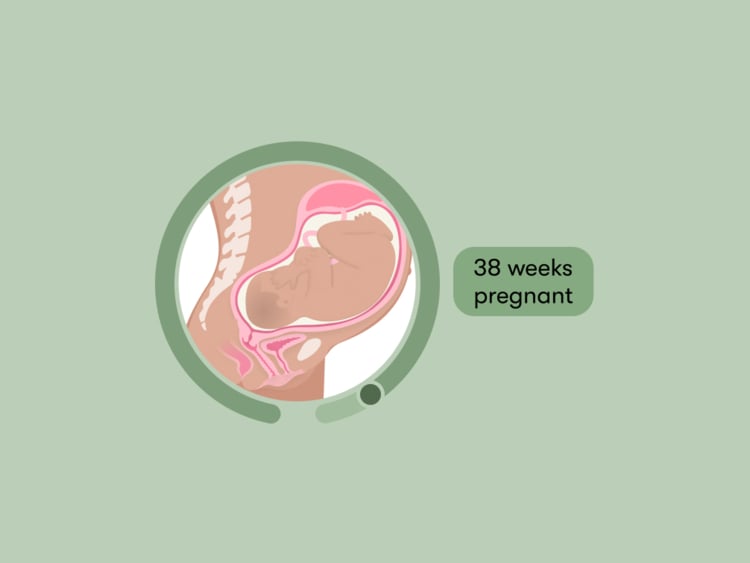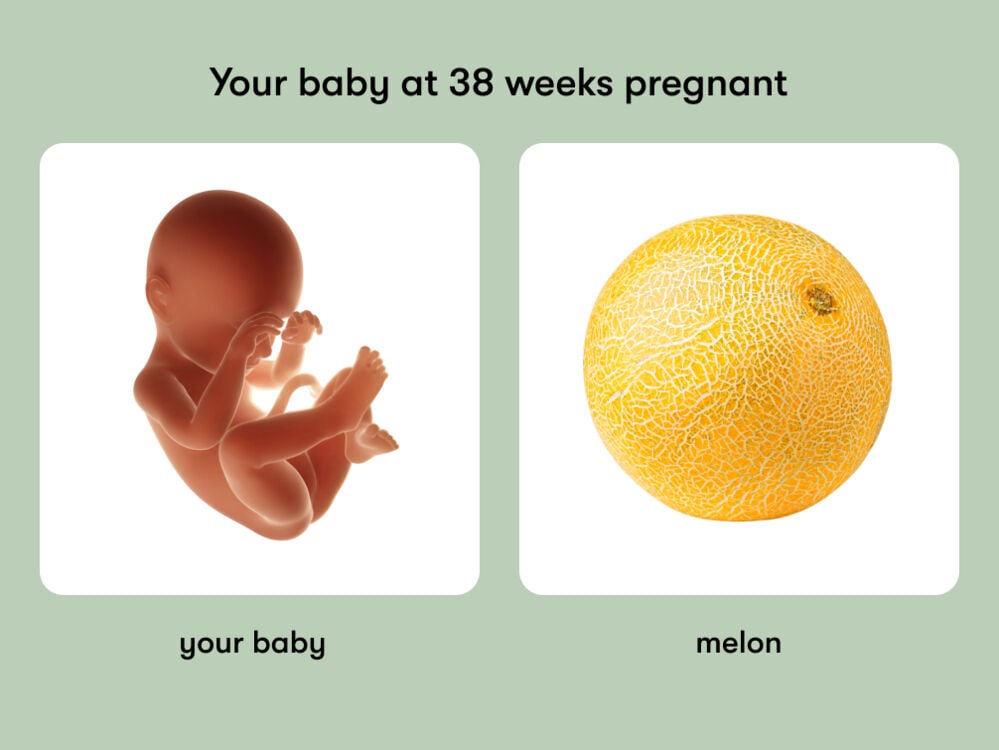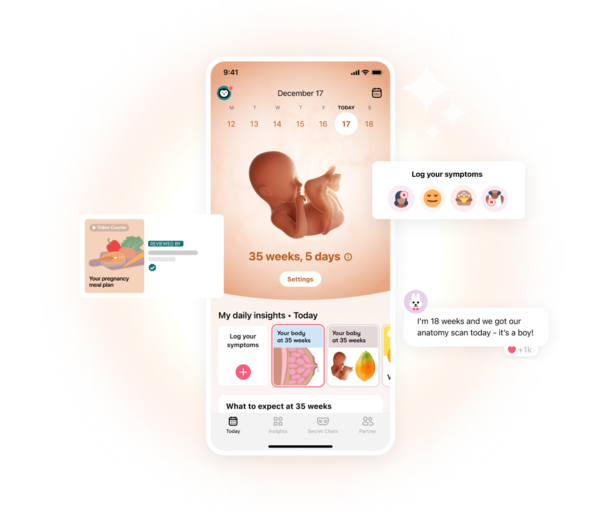From preparing your baby’s nursery to increased vaginal discharge, here’s the lowdown on being 38 weeks pregnant.
-
Tracking cycle
-
Getting pregnant
-
Pregnancy
-
Help Center
-
Flo for Partners
-
Anonymous Mode
-
Flo app reviews
-
Flo Premium New
-
Secret Chats New
-
Symptom Checker New
-
Your cycle
-
Health 360°
-
Getting pregnant
-
Pregnancy
-
Being a mom
-
LGBTQ+
-
Quizzes
-
Ovulation calculator
-
hCG calculator
-
Pregnancy test calculator
-
Menstrual cycle calculator
-
Period calculator
-
Implantation calculator
-
Pregnancy weeks to months calculator
-
Pregnancy due date calculator
-
IVF and FET due date calculator
-
Due date calculator by ultrasound
-
Medical Affairs
-
Science & Research
-
Pass It On Project New
-
Privacy Portal
-
Press Center
-
Flo Accuracy
-
Careers
-
Contact Us
38 weeks pregnant: Your guide to this week of your third trimester


Every piece of content at Flo Health adheres to the highest editorial standards for language, style, and medical accuracy. To learn what we do to deliver the best health and lifestyle insights to you, check out our content review principles.
At 38 weeks pregnant, you’re approaching the end of your pregnancy. This can feel incredibly exciting but also pretty nerve-racking. As your due date gets closer, it can really put into perspective that your family is going to grow, and the baby you’ve talked about throughout your pregnancy journey will finally be here.
You might find guides to labor and delivery pretty handy at this time. For some people, understanding what may be ahead can be the most comforting thing. And to help you understand what’s going on at 38 weeks pregnant, a Flo expert outlines what you might want to think about this week.
Your baby at 38 weeks pregnant
Your baby is almost ready to be born
From 37 weeks, your baby is officially early term. This means that in a few short weeks (from 39 weeks until 40 weeks and six days), they’ll be considered full term, and their due date will be here. Very few babies are actually born on their due date (as few as 5% of babies), with some arriving early and others arriving a little later. So, 38 weeks onward may start to feel like a waiting game.
At this point, your baby is continuing to put on weight, but many of their organs and systems are fully developed. Your baby’s lungs have just about fully matured, and the soft, downy hair (lanugo) that covered them in your second trimester will have nearly all gone away.
Your baby has fully formed toenails
You’ll likely have spent time in your third trimester wondering what your baby will look like. At 38 weeks, their finer details (like their eyelashes and hair) will have grown. They’ve even got fully formed toenails.
How big is a baby at 38 weeks?
Length (crown to heel): 49 cm or 19.4 in
Weight: 3.2 kg or 7.1 lb
Size: Equivalent to a melon
All measurements are approximate and vary within the normal range.

Your body at 38 weeks pregnant
Increased vaginal discharge
You might notice a change in your vaginal discharge at 38 weeks and a change in the amount of discharge you’ve produced during pregnancy. Vaginal discharge plays an important role in preventing infections from entering your uterus via the vagina. Your discharge shouldn’t have a strong smell and may be clear or milky white, but you may have noticed more in your underwear than before you were pregnant.
As you near your due date, you might notice you have even more discharge than has been typical for you during pregnancy. It may appear sticky and pink if it has a little bit of blood running through it. This may be discharged from your mucus plug (keep reading to learn more about that). If you notice blood in your discharge, call your doctor. They may ask you to describe what you’re seeing and advise you on what to do next.
Your mucus plug might come out
You might have heard friends and loved ones talk about their mucus plug and “the show” before they gave birth. Sadly, this doesn’t have anything to do with hot seats on Broadway, but it is quite a spectacle.
While the mucus plug and bloody show are related, they aren’t the same thing. Your mucus plug develops at your cervix in early pregnancy to protect your baby from bacteria. It can be jelly-like, often clear, and thicker than your vaginal discharge, though it may also be tinged with a bit of blood. When your cervix starts to open (or dilate) in the time before your labor begins, it can come out.
When your cervix opens or dilates, the blood vessels can rupture, causing you to bleed. As your mucus plug comes out, and it starts to mix with the blood from your cervix, it can be called “the show” or “the bloody show.”
Your questions answered
Is giving birth at 38 weeks normal?
When it comes to your due date and when you’ll give birth, the last few weeks can be a waiting period. A baby is considered to be full term if they’re from 39 weeks and 40 weeks and six days. If they’re born between 37 weeks and 38 weeks and six days, they’re considered to be early term. Generally speaking, it’s best for a baby to remain in the uterus until they’re full term so they can continue putting on weight and their organs can continue maturing. No two pregnancies and births are the same, and there may be a medical reason why your doctor may recommend that you deliver at 38 weeks. Similarly, you may spontaneously go into labor at 38 weeks. If you do spot any of the signs of labor, then you should speak to your health care professional.
How do you tell labor is a few days away?
At 38 weeks pregnant, you may be on high alert for any cramps or twinges in your bump. Could this mean labor is just around the corner? While it’d be ideal to be able to predict when you’re going into labor with such precision, it often isn’t that simple. However, there are some signs that labor might be close that you can look for. These include:
- Your water breaking: While this might sound like a big event for some people, it can be more of a trickle than a splash. Your baby has been growing in amniotic fluid, which is held together in a membrane. This membrane can break before or during labor, and it can feel a little bit like you’ve peed. If you think your water has broken, it’s crucial to reach out to your health care provider.
- Feeling your baby has dropped lower: As you get closer to giving birth, your baby may drop down, settling their head in your pelvis. This is known as lightening, and it can change the shape of your bump.
- Increased vaginal discharge: As mentioned above, this could be a sign that your mucus plug has dislodged.
- Your cervix starts to dilate: Your doctor will be the one to check this. If you think you’ve gone into labor, then your doctor may check how open your cervix is. It will go from being totally closed to being 10 cm fully dilated.
Why does my belly feel so hard at 38 weeks pregnant?
If this tight or hard feeling in your belly comes and goes at irregular intervals, then this may be Braxton Hicks contractions (or false labor contractions). However, if they become progressively closer together — around every five minutes apart, last around 60 to 90 seconds, and continue regardless of whether you change position, go for a walk, or lie down, then this would indicate that they’re true contractions. In this case, you should reach out to your doctor immediately.
Take a quiz
Find out what you can do with our Health Assistant
38 weeks pregnant checklist
Get ready for your baby’s arrival
You may have been building a pregnancy wish list for your baby since you found out that you were expecting, but 38 weeks pregnant is a great time to start finishing off those bigger purchases. This may mean looking at strollers, ordering a crib, or investing in a bottle sterilizer. Our newborn essentials checklist may help you break down what you need from what you’d really like.
During this time, you may also want to look into who your health care provider will be after you give birth. You can research if any breastfeeding assistance is available to you in your area if you choose to breastfeed. There may also be community groups for new parents for when you feel ready to introduce your newborn to the world.
Pack your hospital bag
Whether you’ve decided to give birth in a medical setting or at home, it can be a great idea to have all of the things you might want and need once you go into labor nearby and ready to go.
It can be difficult to know what to put in your delivery bag. Having your baby book and birth plan with you is important, and you may want to pack items to keep you entertained if your labor takes longer or toiletries so you feel as fresh and comfortable as possible.
Watch for signs of labor
If you’re wondering what you can do in the meantime while keeping an eye out for the signs of labor, Dr. Allison K. Rodgers, reproductive endocrinologist, obstetrician, and gynecologist at Fertility Centers of Illinois, US, suggests that you “try to nap and eat small meals.” Eating smaller meals may help you combat any heartburn that’s bothering you, while naps may ease the tiredness you’re feeling.
Going through your birth plan and any aids (like hypnobirthing or a playlist) that you might want to take into delivery with you may help to calm your mind and communicate any feelings you have about birth to your partner and loved ones. Now could also be a good time to get a prenatal massage from a specialist.
When to consult a doctor at 38 weeks pregnant
At this point in your pregnancy, you might be having prenatal checkups as often as once a week. This can slightly differ depending on where you live. Since you could have your baby any time, it’s crucial to know and watch out for signs that you’re going into labor. These include:
- Your water breaking
- Having regular contractions
- Losing your mucus plug
You don’t need to wait until your appointment if you have any concerns or questions about your pregnancy. However, at 38 weeks pregnant, you should contact your doctor immediately if you experience:
- Severe cramping
- Vaginal bleeding
- Unusual changes in vaginal discharge
- Fever
- Dizziness or fainting
- Severe vomiting
- Severe headaches or blurry vision
- Intense heartburn
- A decrease in the amount you feel your baby move
This isn’t an exhaustive list and just some examples of changes you should look for. Some of these can be a sign of health complications, so it’s essential that you speak to your doctor about the best next step for you. And if you’re worried about any other symptoms you experience during pregnancy, don’t hesitate to reach out to your health care provider.
38 weeks pregnant: The takeaway
At 38 weeks pregnant, you might feel like you’re waiting for your baby’s grand arrival. It can be good to go over your birth plan and keep an eye out for signs of labor, but remember to also prioritize your own comfort and ensure that you’re getting all the rest you need.


Hey, I'm Anique
I started using Flo app to track my period and ovulation because we wanted to have a baby.


The Flo app helped me learn about my body and spot ovulation signs during our conception journey.


I vividly
remember the day
that we switched
Flo into
Pregnancy Mode — it was
such a special
moment.
Real stories, real results
Learn how the Flo app became an amazing cheerleader for us on our conception journey.
References
“Week 38.” NHS, www.nhs.uk/start4life/pregnancy/week-by-week/3rd-trimester/week-38/. Accessed 25 July 2023.
“Urgent Maternal Warning Signs.” Centers for Disease Control and Prevention, www.cdc.gov/hearher/maternal-warning-signs/index.html. Accessed 25 July 2023.
“Cervical Effacement and Dilation.” Mayo Clinic, www.mayoclinic.org/healthy-lifestyle/labor-and-delivery/multimedia/cervical-effacement-and-dilation/img-20006991. Accessed 25 July 2023.
“Bloody Show.” Cleveland Clinic, my.clevelandclinic.org/health/symptoms/21605-bloody-show. Accessed 25 July 2023.
“Fetal Development.” Cleveland Clinic, my.clevelandclinic.org/health/articles/7247-fetal-development-stages-of-growth Accessed 25 July 2023.
“Fetal Development: The 3rd Trimester” Mayo Clinic, 3 June 2022, www.mayoclinic.org/healthy-lifestyle/pregnancy-week-by-week/in-depth/fetal-development/art-20045997.
“Fetal Positions for Birth.” Cleveland Clinic, my.clevelandclinic.org/health/articles/9677-fetal-positions-for-birth. Accessed 25 July 2023.
“Fevers during Pregnancy.” MSD Manual Consumer Version, Sep. 2022, www.msdmanuals.com/home/women-s-health-issues/pregnancy-complicated-by-disease/fevers-during-pregnancy.
Hellegers, Andre E. “Fetal Development.” Theological Studies, vol. 31, no. 1, Feb. 1970, pp. 3–9, https://doi.org/10.1177/004056397003100101.
“How to Tell When Labor Begins.” The American College of Obstetricians and Gynecologists, May 2020, www.acog.org/womens-health/faqs/how-to-tell-when-labor-begins.
“Pregnant? Here’s How Often You’ll Likely See Your Doctor” Cleveland Clinic, 14 Jan. 2022, health.clevelandclinic.org/prenatal-appointment-schedule/.
Khambalia, Amina Z., et al. “Predicting Date of Birth and Examining the Best Time to Date a Pregnancy.” International Journal of Gynaecology and Obstetrics, vol. 123, no. 2, Nov. 2013, pp. 105–09, doi: 10.1016/j.ijgo.2013.05.007.
“Kick Counts.” Cleveland Clinic, my.clevelandclinic.org/health/articles/23497-kick-counts. Accessed 25 July 2023.
“Morning Sickness: Nausea and Vomiting of Pregnancy.” The American College of Obstetricians and Gynecologists, May 2020, www.acog.org/womens-health/faqs/morning-sickness-nausea-and-vomiting-of-pregnancy.
“Mucus Plug.” Cleveland Clinic, my.clevelandclinic.org/health/symptoms/21606-mucus-plug. Accessed 25 July 2023.
“Mucus Plug: What Is It and What Does It Look Like?” National Childbirth Trust, www.nct.org.uk/pregnancy/worries-and-discomforts/common-discomforts/mucus-plug-what-it-and-what-does-it-look. Accessed 25 July 2023.
Nicholson, James M., et al. “New Definition of Term Pregnancy.” JAMA, vol. 310, no. 18, 13 Nov. 2013, pp. 1985–86, doi:10.1001/jama.2013.277993.
“Pregnancy and Birth: When Your Baby’s Due Date Has Passed.” InformedHealth.org, Institute for Quality and Efficiency in Health Care, 22 Mar. 2018, www.ncbi.nlm.nih.gov/books/NBK279571/.
“Heartburn during Pregnancy.” Cleveland Clinic, my.clevelandclinic.org/health/diseases/12011-heartburn-during-pregnancy. Accessed 25 July 2023.
Reynolds, S. R. “The Uses of Braxton Hicks Contractions.” Obstetrics and Gynecology, vol. 32, no. 1, July 1968, pp. 134–40.
“Having a Baby.” The American College of Obstetricians and Gynecologists, July 2022, www.acog.org/womens-health/faqs/having-a-baby.
“Prenatal Massage Benefits and Safety.” Cleveland Clinic, 8 Nov. 2022, health.clevelandclinic.org/prenatal-massage/.
“Signs of Labor: Know What to Expect.” Mayo Clinic, 16 Dec. 2021, www.mayoclinic.org/healthy-lifestyle/labor-and-delivery/in-depth/signs-of-labor/art-20046184.
“Vulvovaginal Health.” The American College of Obstetricians and Gynecologists, Jan. 2020, www.acog.org/womens-health/faqs/vulvovaginal-health.
“Indigestion and Heartburn in Pregnancy.” NHS, www.nhs.uk/pregnancy/related-conditions/common-symptoms/indigestion-and-heartburn/. Accessed 25 July 2023.
“Signs That Labour Has Begun.” NHS, www.nhs.uk/pregnancy/labour-and-birth/signs-of-labour/signs-that-labour-has-begun/. Accessed 25 July 2023.
“Vaginal Discharge in Pregnancy.” NHS, www.nhs.uk/pregnancy/related-conditions/common-symptoms/vaginal-discharge/. Accessed 25 July 2023.
“What Does It Mean to Lose Your Mucus Plug?” The American College of Obstetricians and Gynecologists, Oct. 2020, www.acog.org/womens-health/experts-and-stories/ask-acog/what-does-it-mean-to-lose-your-mucus-plug.
“What You Should Bring.” Mayo Clinic Health System, www.mayoclinichealthsystem.org/locations/eau-claire/services-and-treatments/birthing-centers/getting-ready-for-baby/what-you-should-bring. Accessed 25 July 2023.
“Bleeding during Pregnancy.” The American College of Obstetricians and Gynecologists, www.acog.org/womens-health/faqs/bleeding-during-pregnancy. Accessed 25 July 2023.
History of updates
Current version (08 September 2023)
Published (24 February 2019)
In this article

Get your personal guide to pregnancy with the Flo app
-
Follow your baby's growth week by week
-
Get expert info on symptoms, safe foods, and more
-
Chat with other parents-to-be




